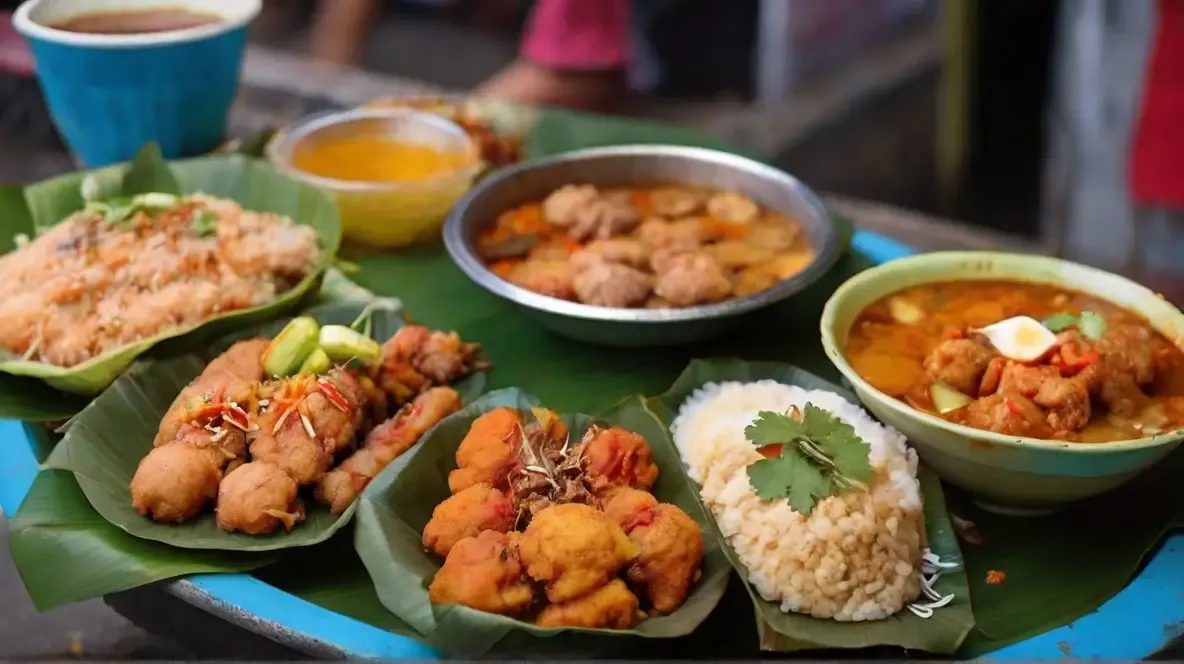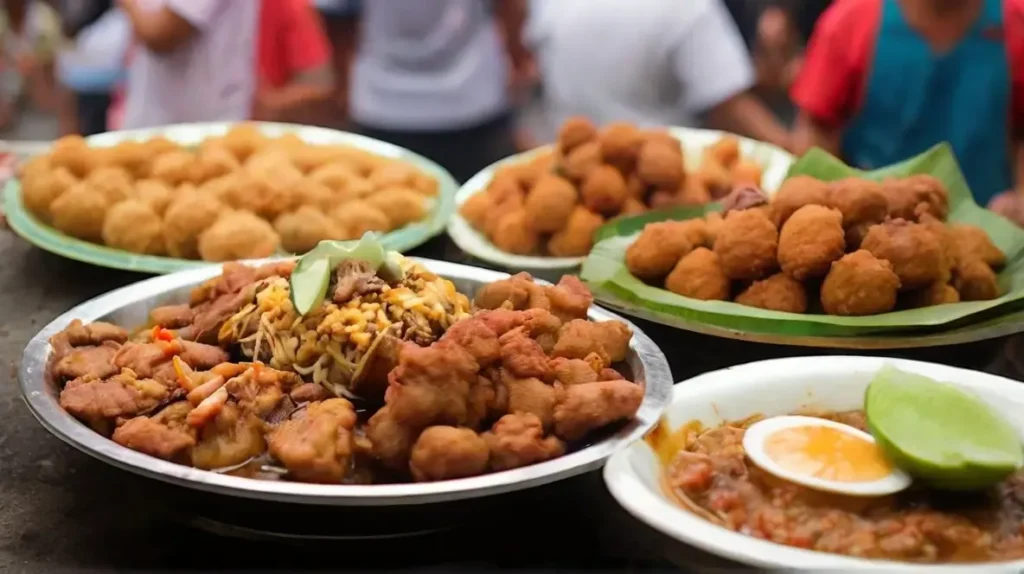12 Filipino Street Food Classics That Will Make Your Mouth Water

Indulge in the delectable array of Filipino street food classics that will surely tantalize your taste buds and leave you craving more.
From the infamous balut to the sweet and refreshing halo-halo, there’s something for everyone to enjoy. In this blog post, you’ll discover 12 mouthwatering street food favourites that are beloved by locals and tourists alike.
Each of these street food classics offers a unique blend of textures, aromas, and tastes that you won’t find anywhere else. Whether you’re a fan of savoury, sweet, or a combination of both, you’re sure to find a Filipino street food favourite that will leave you coming back for more.
So, get ready to tantalize your taste buds and satisfy your cravings as you dive into the world of Filipino street food.
Key Takeaways:
- Balut: This popular Filipino street food is a developing duck embryo that is boiled and eaten from the shell. It is a unique and flavorful delicacy that is not for the faint of heart.
- Kwek-Kwek and Isaw: These deep-fried delicacies are a must-try for anyone looking to experience the vibrant and diverse flavours of Filipino street food. Kwek-kwek are quail eggs coated in an orange batter, while isaw is grilled chicken or pork intestines on a skewer.
- Fish Balls and Taho: Fish balls are a beloved street food favourite, consisting of deep-fried fish balls served with a sweet and spicy sauce. Taho, on the other hand, is a sweet and creamy snack made from soft tofu, arnibal (sweet syrup), and sago pearls.
Balut: The Filipino Exotic Delicacy
One of the most famous Filipino street foods is balut, a popular exotic delicacy that can be found in street stalls and vendors throughout the Philippines. If you’re a fan of trying new and unique foods, balut should be on your list of things to try when visiting the Philippines.
What Is Balut?
If you’ve never heard of balut before, you may be wondering what exactly it is. Balut is a fertilized duck embryo that is boiled and eaten directly from the shell. The embryo is typically between 14-21 days old, at which point it has developed bones, feathers, and beaks. While it may sound a bit daunting, balut is considered a delicacy in Filipino cuisine and is a staple street food.
The Cultural Significance of Balut
In the Philippines, balut is more than just a street food – it holds cultural significance and is a symbol of Filipino cuisine. It is often seen as a source of pride and a representation of Filipino identity and is a must-try for anyone looking to experience the richness of Filipino food culture. Trying balut can also be a way for you to connect with the local community and gain insight into traditional Filipino customs and practices.
How To Eat Balut
When it comes to eating balut, there is a specific technique you should follow. To begin, crack open the shell and sprinkle a bit of salt and vinegar over the exposed embryo. Next, slurp up the flavorful broth before peeling away the shell to reveal the partially developed duck embryo. Some people enjoy eating the entire balut, while others prefer to discard certain parts. The key is to savour the unique flavour and texture of this exotic delicacy.
Kwek-Kwek: The Colorful Street Snack
After trying balut, you may want to wash down the unique experience with a plate of kwek-kwek. Kwek-kwek is a popular street food in the Philippines known for its vibrant and eye-catching appearance. These deep-fried snacks are made from quail eggs coated in a bright orange batter, earning them the nickname “orange eggs” on the streets. The name “kwek-kwek” actually comes from the sound the quail eggs make when they hit the hot oil and begin to sizzle.
The Origins and Ingredients of Kwek-Kwek
The origins of kwek-kwek can be traced back to the traditional Filipino snack called tokneneng, which is made with chicken eggs instead of quail eggs. The quail egg version rose to popularity in the 1980s and has since become a staple in Filipino street food culture. The main ingredients for kwek-kwek include quail eggs, orange food colouring, flour, cornstarch, salt, and pepper.
The eggs are first boiled, then peeled, coated in the batter mixture, and deep-fried until they achieve a crispy texture.
Serving and Pairing Suggestions
When it comes to serving kwek-kwek, they are typically skewered on bamboo sticks and served with a dipping sauce. The most common dipping sauce is a spicy vinegar-based mixture, which complements the richness of the fried eggs. Kwek-kwek is often paired with other Filipino street foods such as fish balls and isaw. These savoury snacks are best enjoyed hot and fresh from the fryer, making them a go-to choice for a quick and delicious snack on the go.
Isaw: Philippines’ Favorite BBQ Skewer
Isaw is a popular Filipino street food made from marinated and grilled chicken or pork intestines. It is often enjoyed as a snack or appetizer, and its unique flavour and chewy texture make it a favourite among locals and tourists alike.
What Goes Into Making Isaw
Making isaw involves a meticulous preparation process to ensure that the intestines are thoroughly cleaned before they are skewered and grilled. The intestines are carefully washed and scraped to remove any traces of waste, then they are boiled until tender.
Once the intestines are cleaned and prepped, they are marinated in a flavorful mixture of soy sauce, vinegar, garlic, and various spices to enhance the taste. After marinating, the skewers are grilled over hot coals until they develop a smoky flavour and a charred, crispy exterior.
Tips for Enjoying Isaw Safely
When indulging in isaw, it’s important to consider a few safety tips to ensure a pleasant dining experience. Firstly, make sure to purchase isaw from a reputable street vendor who follows proper hygiene practices. Secondly, inspect the appearance of the isaw to ensure that it has been thoroughly cooked and is free from any signs of spoilage. Finally, enjoy your isaw with a side of vinegar, soy sauce, and chilli garlic dip to add an extra layer of flavour.
- Purchase isaw from reputable vendors
- Inspect appearance for thorough cooking and freshness
- Enjoy with vinegar, soy sauce, and chilli garlic dip
The indulgence of authentic Filipino street food like isaw is a truly unforgettable experience and a must-try for any visitor to the Philippines. Rest assured that with the right precautions in place, you can savour this beloved delicacy with confidence.
Fish Balls: The Quintessential Filipino Snack

When it comes to Filipino street food, fish balls are a timeless classic that never fails to satisfy your cravings. These savoury, deep-fried snacks are a staple of street food vendors across the Philippines, and their irresistible taste and affordable price make them a popular choice for locals and visitors alike.
The Process of Making Fish Balls
Unlike other street foods, the process of making fish balls is a meticulous one that requires skill and patience. The main ingredient, typically a mixture of fish meat, flour, and seasonings, is carefully formed into small balls before being deep-fried to perfection. The result is a crispy golden exterior that gives way to a tender and flavorful centre.
The Art of Fish Ball Dipping Sauces
No fish ball experience is complete without a selection of dipping sauces to enhance the flavour. There are numerous options to choose from, including sweet and sour, spicy vinegar, and tangy ketchup-based sauces. The art lies in finding the perfect balance of flavours to complement the savoury fish balls, adding an extra layer of taste to every bite.
Taho: The Sweet Morning Tonic
To start your day like a true Filipino, you must try taho. This sweet and comforting treat is a popular street food that is often enjoyed as a breakfast or mid-morning snack. Taho vendors can be found on street corners, peddling their wares to passersby. The mere sight and smell of taho can lift your spirits and tantalize your taste buds. It is a delightful way to experience the local culture and cuisine.
The Composition of Taho
Taho is made from three main ingredients: soft tofu, arnibal (a caramel-like syrup), and sago pearls. The soft tofu provides the base of this sweet treat, while the carnival adds a rich, sugary flavour. The sago pearls, made from tapioca, provide a delightful texture that contrasts with the smoothness of the tofu. The combination of these ingredients results in a dessert-like concoction that is both indulgent and satisfying.
Serving Rituals of Taho
When you order taho from a vendor, you will receive it in a clear plastic cup or bowl. The tofu is scooped into the container, followed by a generous drizzle of arrival. Sago pearls are then added on top, creating a visually appealing and delicious treat. The taho vendor will provide you with a long-handled spoon, allowing you to savour each layer of this delectable snack.
It is customary to consume Taho while it is still warm, as this enhances the flavours and textures of the dish.
Banana Cue and Turon: The Sweet Street Treats
Despite their simplicity, banana cue, and turon are two of the most beloved sweet street treats in the Philippines. Whether you’re walking down the bustling streets of Manila or visiting a local food market, the aroma of caramelized bananas and crispy lumpia wrappers will surely catch your attention.
These delightful snacks are not only popular among locals but also among tourists who are looking to savour the unique flavours of Filipino cuisine.
Banana Cue: The Deep-Fried Banana Delight
When you crave something sweet and satisfying, the banana cue is the perfect choice. This classic Filipino snack features ripe saba bananas coated in caramelized brown sugar and skewered on bamboo sticks. The bananas are deep-fried to perfection, creating a crispy and caramelized exterior, while the inside remains soft and tender.
As you take your first bite, you’ll experience a delightful combination of sweetness and crunchiness that will leave you craving more.
Turon: The Crispy Banana Lumpia
Another irresistible sweet treat is Turon, which is essentially a crispy banana lumpia. Saba bananas are wrapped in spring roll wrappers along with slices of ripe jackfruit, then deep-fried until golden and crunchy. The caramelized brown sugar adds a hint of sweetness to the Turon, making it a delectable snack that’s perfect for satisfying your sweet tooth.
The contrast between the crunchy exterior and the soft, caramelized filling creates a delightful texture that you won’t be able to resist.
Adventurous Bites: Adidas and Betamax
Not all Filipino street food is for the faint of heart, and if you’re feeling adventurous, you might want to try out some Adidas and Betamax. These unique dishes are not for everyone, but they are worth a try if you’re looking to expand your culinary horizons.
Adidas: Not Just a Shoe Brand
When you hear the word “Adidas,” you probably think of the popular sports brand. However, in the Philippines, adidas refers to a unique street food made from grilled chicken feet. While the concept might sound unusual to you, many Filipinos consider it a delicacy. The preparation involves marinating the chicken feet in a flavorful combination of soy sauce, vinegar, and various spices before grilling them to perfection.
The result is a savoury and slightly chewy snack that pairs perfectly with a vinegar-based dipping sauce. If you’re feeling adventurous, give Adidas a try and embrace the local flavours of the Philippines.
Betamax: Sizzling Blood Cubes
Another daring street food that you might encounter in the Philippines is Betamax. No, we’re not talking about the old-school videotapes – betamax refers to grilled blood cubes. This unique snack earns its name from its resemblance to the shape of the outdated Betamax video format. Made from coagulated pork or chicken blood, betamax is typically marinated in a savoury blend of spices before being skewered and grilled to perfection. T
he result is a sizzling and slightly crispy treat that packs a powerful flavour punch. While the idea of consuming blood might be off-putting to some, Betamax is a popular option for adventurous foodies looking to experience the diverse world of Filipino street food.
The Creamy Delights: Sorbetes and Dirty Ice Cream
Now, let’s talk about the creamy delights that are sorbetes and dirty ice cream. These sweet treats are beloved by Filipinos of all ages and are a must-try for anyone looking to experience the unique flavours of Filipino street food.
Sorbetes: The Traditional Filipino Ice Cream
When it comes to Filipino ice cream, sorbets are the traditional go-to treat. Made with coconut milk, sugar, and various flavours such as mango, ube (purple yam), and cheese, sorbet has a rich and creamy texture that sets it apart from regular ice cream.
You can often find sorbet vendors using a wooden cart with a bell attached, signalling their arrival in your neighbourhood. The distinct sound of the bell is the unmistakable call to enjoy a scoop of this delicious frozen delight.
Dirty Ice Cream: A Misnomer with a History
Despite its name, dirty ice cream is anything but unclean. The term “dirty” actually refers to the fact that it is homemade and sold on the streets, not from a commercial ice cream parlour. This type of ice cream is typically made with a combination of coconut milk, sugar, and various flavours such as avocado, queso, and chocolate.
The creamy, smooth texture and unique flavours make it a popular choice among Filipinos. Whether you choose to have it on a cone or sandwiched between pandesal bread, dirty ice cream is a true classic that you won’t want to miss.
Halo-Halo: The Ultimate Filipino Dessert Medley
For a truly delightful and unique dessert experience, look no further than Halo-Halo. This popular Filipino treat is a delightful mix of flavours and textures that will leave you craving for more. From the colourful layers to the variety of ingredients, Halo-Halo is a must-try for any food lover.
Unpacking the Layers of Halo-Halo
When you dig into a serving of Halo-Halo, you’ll discover a delightful mix of ingredients that create a symphony of flavours and textures. From sweetened fruits like bananas, jackfruit, and beans to creamy shaved ice, evaporated milk, and topped with leche flan and ube (purple yam) ice cream, each layer contributes to the overall taste experience.
The combination of ingredients may sound unusual, but it all comes together in a harmonious blend that will surprise and delight your taste buds.
How to Enjoy Halo-Halo
To fully enjoy the experience of Halo-Halo, you need to mix it up! Use a spoon to thoroughly blend all the layers, ensuring that each scoop contains a bit of everything. This way, you’ll get the full range of flavours and textures that make Halo-Halo such a beloved dessert. Don’t be afraid to dig deep into the glass to get all the layers in one bite, and feel free to customize the toppings to suit your taste preferences.
The beauty of Halo-Halo is that it’s customizable, so you can experiment with different combinations until you find your perfect mix.
Surprising Facts About Filipino Classic Street Food
- 🦐 Balut Surprise: Balut, a popular Filipino street food, is a fertilized duck embryo. What might surprise you is that the embryo’s age varies, and some balut vendors offer a “bonus” or surprise egg with a more developed embryo for those seeking a unique experience.
- 🍢 Betamax on the Grill: “Betamax” is not just a brand; it’s also a term used for grilled chicken or pork blood on skewers. This Filipino street food got its name because the congealed blood resembles the shape of Betamax tapes commonly used in the past.
- 🍡 Adidas Delight: Adidas isn’t just a sports brand; in the Philippines, it’s also a street food made from marinated and grilled chicken feet. The dish got its name from the similarity of chicken feet to the popular sportswear’s three stripes.
- 🍚 Taho Magic: Taho is a sweet snack consisting of silken tofu, arnibal (sweet syrup), and sago pearls (similar to tapioca). What’s surprising is the traditional way it’s sold – by a taho vendor shouting “taho” while carrying two large containers suspended on a bamboo pole.
- 🍌 Turon Transformation: Turon is a sweet snack made by wrapping slices of banana and sometimes jackfruit in a spring roll wrapper, then frying until crispy. A surprising twist is that some vendors include a slice of sweet potato or purple yam, adding an unexpected flavour and colour.
- 🍢 Walkman Wheels: “Walkman” isn’t just a blast from the past; in Filipino street food slang, it refers to fish balls. These fish ball vendors push their carts through the streets, creating a mobile experience reminiscent of someone walking with a portable cassette player.
- 🦑 Adobong Pusit Portable: Adobong Pusit, a delicious squid dish, becomes a portable delight when served on a stick. Vendors skewer the adobo-marinated squid, making it easy for on-the-go enjoyment.
- 🍲 Soup in a Bag: “Batchoy in a bag” is a unique street food concept where the classic Filipino noodle soup, Batchoy, is served in a plastic bag. This makes it convenient for people to enjoy their soup while on the move.
- 🥚 Kwek-kwek Mystery: Kwek-kwek, quail eggs coated in orange batter and deep-fried, is a popular street food. The mystery lies in the origin of its name, which is believed to be an onomatopoeic term for the sound quail eggs make when they hit the hot oil.
- 🍡 Fish Balls’ Special Sauce: Fish balls, a common Filipino street food, come with a special sweet and spicy sauce. The surprising element is the varying secret recipes each vendor has for their sauce, making it a unique experience at every street corner.
Discover the Delightful World of Filipino Street Food Classics
Filipino street food offers a diverse and flavorful range of unique dishes, from the exotic balut to the sweet taho and savoury kwek-kwek. Each street food item represents a blend of traditional flavours and textures, providing a delightful culinary experience that reflects the rich heritage of Filipino cuisine. Whether it’s the must-try balut or the comforting taho, indulging in Filipino street food is an opportunity to savour the vibrant and diverse flavours of the Philippines.
Frequently Asked Questions
Q: What is balut?
A: Balut is a fertilized duck egg that is boiled and eaten from the shell. It is a popular street food in the Philippines and is often seasoned with salt, vinegar, or chilli.
Q: What is kwek-kwek?
A: Kwek-kwek is a Filipino street food made of quail eggs that are coated in orange batter and deep-fried. It is often served with a spicy vinegar dipping sauce.
Q: What is Taho?
A: Taho is a sweet snack made of soft tofu, arnibal (caramelized syrup), and sago pearls. It is often sold by street vendors in the morning and is a popular breakfast item in the Philippines.






